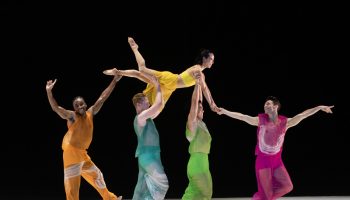Ballet Hispánico will shatter stereotypes while dancing across the Amphitheater stage. This multicultural group hopes to lead the conversation on advocacy and artistic excellence through innovation on stage.
“Ballet Hispánico is beyond its name. It’s very much what we’re all talking about today; don’t judge a book by its cover or its name. There’s more to a name, especially when at the time this organization was developed, Hispanic was the word being used. And funny enough, Hispanic is not in the Spanish vocabulary,” said Eduardo Vilaro, artistic director and CEO of Ballet Hispánico.
Vilaro said the group draws from cultural traditions, but also brings modern concepts to their performances.
“It’s still our history and our legacy, and we love it, but we are a contemporary voice of the Latinx community. We build new narratives to show who we are as Latinate people today.”
At 7 p.m. Wednesday, Aug. 3 at Hultquist Center, Chautauqua Dance Circle hosts a Ballet Hispánico dance preview before the main performance at 8:15 p.m. on the Amp stage, which will feature a wide variety of Latnix-inspired dancing and Mexican music. Immediately after the Amp performance, Ballet Hispánico will host a Post-Performance Fiesta, at 10:30 p.m. in the Carnahan Jackson Studios, which will require a ticket purchase. With all their events at Chautauqua, Ballet Hispánico, a self-described BIPOC organization, hopes to inspire through dance. This mission first started over five decades ago.
“We are 52 years old. We have been serving the community, giving them voice and also access to good arts, education and pride,” Vilaro said. “We continue that mission today. It’s needed today so that we understand each other a little bit more, and we understand that the culture is not singular, it’s not a monolith. It’s full of intersection and intersectionality.”
The Amp performance will feature three pieces: “Con Brazos Abiertos,” “Tiburones” and “Club Havana.” The opener, “Con Brazos Abiertos,” translates to “with open arms,” and is choreographed by Michelle Manzanales who is Mexican-American.
“It really looks at the struggle of all the immigrants and fitting in, from the social and the personal side, in a very beautiful, bittersweet way. But also there’s mirth,” Vilaro said. “This is a gorgeous piece. It’s all Mexican music — some that are contemporary, and some that’s a little bit more dated. Even poetry is included. It’s a beautiful work.”
“Tiburones” follows the performance’s intermission, bringing Ballet Hispánico back onto the stage. Vilaro described “Tiburones” as their answer to the recent conversation surrounding the Steven Spielberg film “West Side Story.”
“For the Latinx community, ‘West Side Story’ is something that is very full of scars. It pigeonholed and stereotyped us,” Vilaro said.
“Tiburones” is choreographed by Annabelle Lopez Ochoa, a Latina choreographer, and it works to reclaim culture from mainstream media.
“She is really talking about who we are as a community, that we’re not what the media tells us or shows us that we are. We’re much more than that,” Vilaro said. “This is a fun and athletic piece.”
“Club Havana” finishes off the performance with traditional celebration. Choreographed by Pedro Ruiz, this piece is described by the group as Latin dancing at its best.
“We bring in the gorgeous ‘Club Havana,’ which is harkening back to the 1950s Ballroom Cuba, as a celebration and an end,” Vilaro said.
The celebration does not stop with “Club Havana” though, as the night continues with the Post-Performance Fiesta in hopes of bringing people together through movement and rhythm.
“That entails dancing together and exploring movement because dance is for everyone,” Vilaro said. “Here in the States we’re so terrified of, ‘Oh, I have two left feet.’ ”
But, Vilaro said that in Afrocentric cultures, dance is incorporated into every part of life. He hopes to bring that to Chautauqua, with a sense of “community in learning to be in those rhythms.”
Vilaro also hopes Chautauquans walk away from the evening able to have conversation on what it means to be Latinx in the current world.
“I hope it starts an inquiry and a dialogue and just sheer joy at these incredible, beautifully diverse dancers on stage,” Vilaro said.




